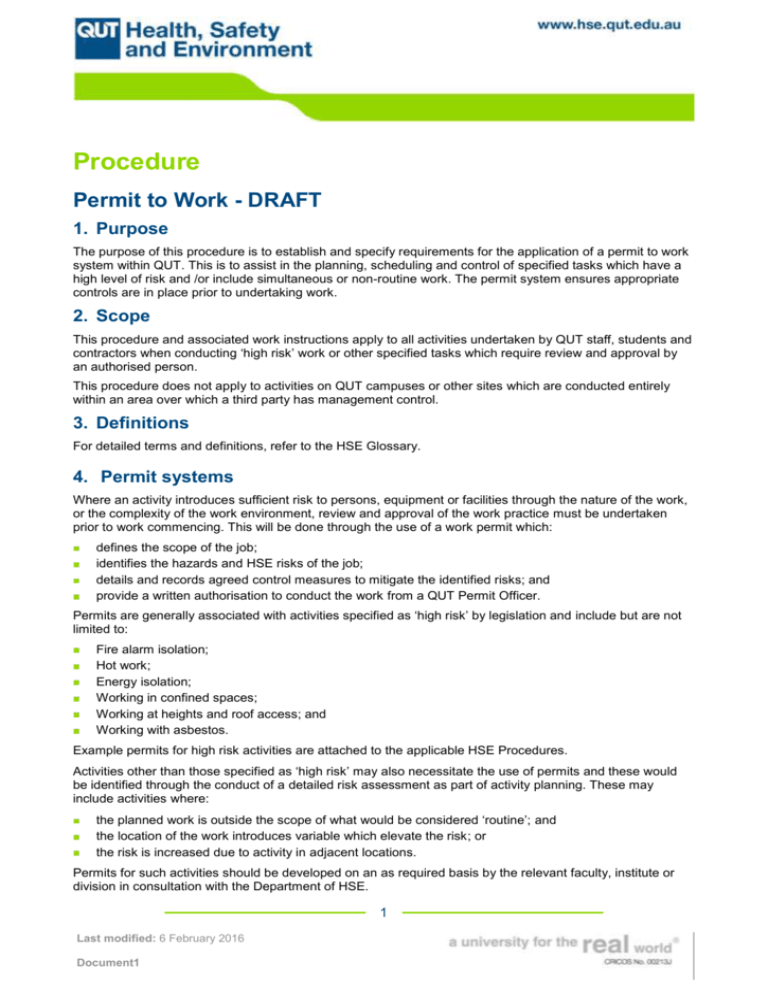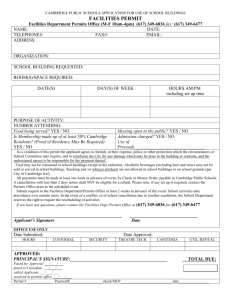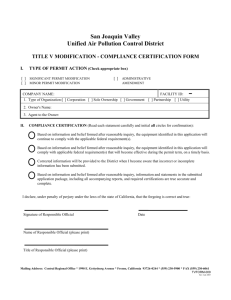Permit to Work - DRAFT - QUT - Health, Safety and Environment
advertisement

Procedure Permit to Work - DRAFT 1. Purpose The purpose of this procedure is to establish and specify requirements for the application of a permit to work system within QUT. This is to assist in the planning, scheduling and control of specified tasks which have a high level of risk and /or include simultaneous or non-routine work. The permit system ensures appropriate controls are in place prior to undertaking work. 2. Scope This procedure and associated work instructions apply to all activities undertaken by QUT staff, students and contractors when conducting ‘high risk’ work or other specified tasks which require review and approval by an authorised person. This procedure does not apply to activities on QUT campuses or other sites which are conducted entirely within an area over which a third party has management control. 3. Definitions For detailed terms and definitions, refer to the HSE Glossary. 4. Permit systems Where an activity introduces sufficient risk to persons, equipment or facilities through the nature of the work, or the complexity of the work environment, review and approval of the work practice must be undertaken prior to work commencing. This will be done through the use of a work permit which: defines the scope of the job; identifies the hazards and HSE risks of the job; details and records agreed control measures to mitigate the identified risks; and provide a written authorisation to conduct the work from a QUT Permit Officer. Permits are generally associated with activities specified as ‘high risk’ by legislation and include but are not limited to: Fire alarm isolation; Hot work; Energy isolation; Working in confined spaces; Working at heights and roof access; and Working with asbestos. Example permits for high risk activities are attached to the applicable HSE Procedures. Activities other than those specified as ‘high risk’ may also necessitate the use of permits and these would be identified through the conduct of a detailed risk assessment as part of activity planning. These may include activities where: the planned work is outside the scope of what would be considered ‘routine’; and the location of the work introduces variable which elevate the risk; or the risk is increased due to activity in adjacent locations. Permits for such activities should be developed on an as required basis by the relevant faculty, institute or division in consultation with the Department of HSE. 1 Last modified: 6 February 2016 Document1 Permit to Work - DRAFT 5. Authority to issue permits Were required, permits to work may only be issued by specified ‘High Risk Permit Officers’ (Permit Officers), following their review and approval of the planned work. Permit officers may only issue permits for high risk work tasks for which they are qualified and authorised. Faculties, Institutes and Divisions are responsible for defining internal permit officer requirements and ensuring that these persons are appropriately skilled and qualified to enable them to perform this function. Where known or planned work does not warrant the maintenance of specific permit officers, permit officers from other faculties, institutes or divisions may be requested to review work plans and issue permits for high risk work. Such support is subject to capacity constraints of the permit officer and management approval. The QUT Department of HSE is responsible for ensuring that permit officer information is made available across the university through the QUT intranet; however, Faculties, Institutes and Divisions are responsible for ensuring the currency of the permit officer information provided. 6. Planning All tasks involving high risk work require detailed planning to ensure the effective identification and management of risk and to ensure that the work is conducted in a manner so as to not adversely affect other areas or activities. The requirement for the issue of a work permit should be identified during the planning stage for a task and this is supported by the conduct of either a detailed risk assessment or a QUT Risk Check. Planning must identify the potential for the issue and management of multiple concurrent permits within the same work area and consider how the risks associated with these tasks will be managed. Risk assessment and QUT risk check All high risk work activities, regardless of task, process, equipment or environment must be the subject of a detailed risk assessment and recorded in the applicable risk register. Prior to commencing any work and independent of any requirement for a permit, all high risk work tasks must be subject to a daily analysis of the task and inspection of the work environment by applying the QUT Risk Check process. Work Instructions Where particular high risk tasks are conducted as part of routine activities, or conducted with sufficient frequency, faculties / institutes / divisions should develop work instructions to detail the method for the undertaking the work task. These must be specific to the work environment and the high risk work task being undertaken, address risks and incorporate relevant controls identified through the risk assessment. Where an approved work instruction exists, detailed risk assessments for each occurrence are not required. Additionally, the existence and application of a current work instruction may remove the requirement for high risk work to be conducted under a permit. Further detail on where this may be relevant is located in procedures and work instructions for applicable high risk activities. 7. Permit issue process Compilation of the permit Prior to their approval and issue, permits should be compiled by the person who is going to conduct the work. If compiled by someone other than person conducting the work, that person must have some level of management control over the activity (E.g. supervisor of the person conducting the work). If specific technical qualifications are required for the compilation of the permit (and / or completion of the work), these will be specified through applicable procedures, work instructions or other direction.* * Note - If compiled by someone other than person conducting the work, that person must brief the person conducting the work on the issues risks and controls to be applied prior to any work commencing. 2 Last modified: 6 February 2016 Document1 Permit to Work - DRAFT Compilation of permits must include a review of existing procedures, risk assessments and / or work instructions that address the planned work. In addition to detailing the nature and scope of the task, the hazards, risks and associated controls specified in these documents must be reflected in the permit. Approval and issue On receipt of the permit, the permit officer must review the nature and scope of the task, the adequacy of planned risk controls as well as the potential impact on activities, areas or persons adjacent to the work. If satisfied that identified risks will be adequately controlled, the permit officer shall approve the work. Permit officers may elect to issue permits for periods greater than 1 day where the work is being conducted over consecutive days.* Such approvals must reflect the nature of the work and the assessed level of risk. * Note - Permits issued for durations greater than 1 day do not diminish the requirement for persons conducting the work to conduct a daily analysis of the task and inspection of the work environment. Management of multiple permits Where work involves multiple and combined high risk tasks (eg hot work at height or in a confined space), the permit officer(s) must consult as part of the approval process and ensure that the cumulative effects of the high risk tasks are identified and managed. Where work involves multiple, yet stand-alone high risk tasks within the same vicinity, the person with management control of the work shall ensure that the respective tasks do not adversely affect each other. Withdrawal Permits may be withdrawn by permit officers at any time where they identify: unsafe work practices or deviation from specified risk controls; or significant changes to the work environment outside those considered in the issue of the permit Records retention Faculties, Institutes and Divisions must ensure that copies of permits are retained for record keeping purposes. 8. Responsibilities Managers/supervisors For high risk work practices conducted in areas within their influence or control, managers and supervisors at all levels are responsible for: ensuring that such work practices are subject to detailed risk assessments and recorded in applicable risk registers; ensuring that work permits are sought and issued in accordance with this and other applicable procedures; and ensuring that completed work permits are retained for record keeping purposes. Person conducting high risk work Persons conducting high risk work are responsible for: undertaking the necessary planning for the conduct of the high risk work task; obtaining a work permit in accordance with this and other relevant procedures, or where determined by a detailed risk assessment; conducting a daily risk check and ensuring that all controls specified in the work permit are in place and maintained throughout the task; operating equipment in accordance with manufacturer’s instructions; wearing PPE appropriate for the work being conducted; stopping the work if it becomes unsafe or a serious incident occurs; and reporting any incidents or conditions that affected their ability to conduct the work as planned. 3 Last modified: 6 February 2016 Document1 Permit to Work - DRAFT Permit Officers Permit Officers authorised for approving specified high risk work are responsible for: reviewing plans for the conduct of the work (where required) and verifying the effectiveness of identified controls; providing advice to managers, supervisors and persons conducting high risk work on safe work practices; monitoring high risk work to ensure that it does not / will not impact on other work on the site and equally that other work will not affect the safety of those doing the high risk work; approving high risk work tasks through the issue of work permits; and conducting inspections, where considered appropriate, of approved high risk work tasks to ensure that the work is being conducted in accordance with the requirements of the permit. Contractors Contractors conducting high risk work for or on behalf of QUT shall apply the requirements outlined in this procedure. Contractors they may seek approval from the QUT person commissioning the work to use their own permit forms, if it can be demonstrated that the QUT permit is not suitable for the work being conducted. In such cases, the permit must still be approved and issued by a QUT permit officer. 9. Associated documentation Guidance Information Procedures HSE PRO – Risk management HSE PRO – Hot work HSE PRO – Working at height HSE PRO – Confined space entry Forms Lists 10. Document history Title: Document Number: Author: Document Owner: Review Interval: Version Number Paragraph Description 4 Last modified: 6 February 2016 Document1 Date Approved by





